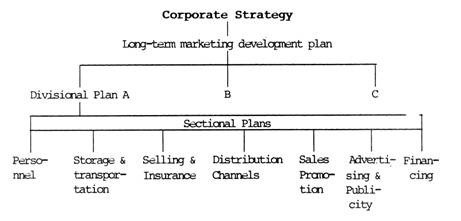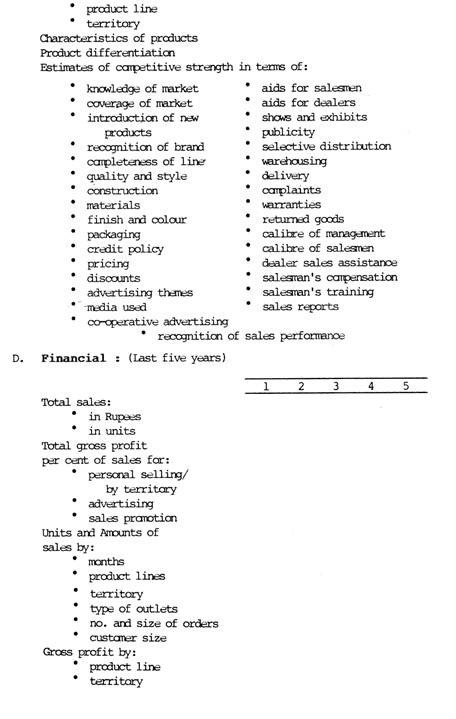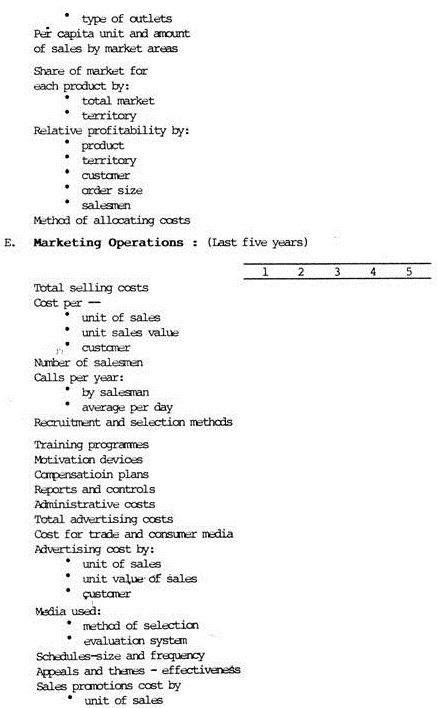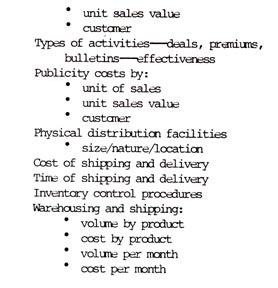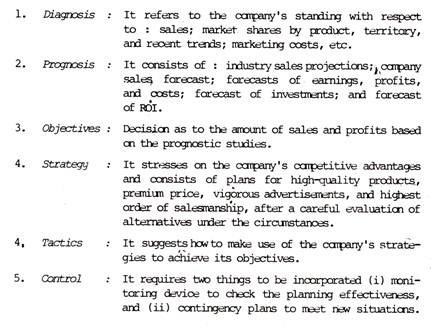Some of the frequently asked exam questions on marketing planning and plans are as follows:
Q.1. Write short notes on ‘hierarchy’ of marketing plans.
Ans. The term ‘hierarchy’ of marketing plans refers to the structure of formal marketing plans as a pyramid, with the corporate strategy and the long-term marketing plan at the top and then the more detailed divisional plans as also the plans of several sections relating to the marketing activities needed to implement then.
An illustration is given below:
In most cases, there will be a similar hierarchical pattern for both long-term and short-term planning for marketing.
Q.2. As an executive assistant of the chief marketing manager of a large industrial organisation, prepare a checklist or an information schedule that may be used as a guide for marketing planning.
Ans. Checklist for Marketing Planning:
For the purpose of marketing planning to be designed by the Chief Marketing Manager of a large industrial organisation, the executive assistant while preparing a checklist should consider information on market segments within which the organisation competes including anticipated competitive action; shifts in market structure and channels of distribution, price trends/ and the legal and regulatory environment, apart from overall planning premises.
He will also need information on the characteristics of the existing marketing operation and its recent history, usually over the last five years.
In nutshell, the checklist should cover such areas as:
A. Product,
B. Market, and
C. Competition.
A. Product:
Models and sizes
Materials, workmanship, method of manufacturing design, and unique characteristics. Packaging-size, shape, label, competitive value
Brand-memory value, suggestiveness, legal protection, value
Price by product:
1. At factory
2. To wholesalers by type, size, territory
3. To retailers by type, size, territory
4. Discounts-quality, cash, other rebates
5. Service charges
6. Fair-trade position
Service-inspection, repair, refinishing, delivery and credit terms.
Returned goods.
Warranties and complaints.
B. Market:
Number of actual and potential consumers by territory characteristics of consumers – age, income, occupation, location, housing, sex, size of family, colour, etc.
Place of purchase Size of purchase Time of purchase Method of purchase:
1. Brand
2. Impulse vs. planned
3. Inspection
4. Cash vs. credit Purchase motivations and influences
Attitudes towards product:
Wholesalers’ and Retailers’ opinions Shifts in importance of distribution channels
C. Competition:
Number aid name of competitors-location and size Number of brands:
1. Local and regional
2. National and international
Share of market by:
Q.3. What do you mean by long term marketing planning? State its essential characteristics and process.
Ans. The long-term planning for marketing may be defined as a systematic and formalised process for purposefully directing and controlling future’ marketing operations of an organisation towards desired marketing objectives for periods extending beyond one year.
The long-term planning for marketing covers a time period which is long enough to provide the marketing management with an opportunity to anticipate future problems, and thus to have a greater freedom of action to resolve them in an orderly manner.
The marketing management can establish its long-term objectives and then decide its strategy for achieving its objectives. This stage of long-term marketing planning has become to be known as the strategic marketing planning.
According to Peter F. Drucker, “long-range planning is not masterminding the future. (It) does not deal with future decisions. It deals with the futurity of present decisions. (It) is not an attempt to eliminate risk. Rather it seeks to raise the capacity to take risks”. These have great relevance to a long-term planning for marketing also.
The major characteristics of LTMP are:
(1) LTMP thinks ahead beyond the horizon of current events, current policies, and strategies.
(2) It appraises the present and potential strengths and weaknesses of an organisation so that not only the future opportunities are matched with the capabilities of the organisation but in the long run the capabilities of the firm are shaped to future business opportunities.
(3) It provides a structure or a set of plans for the entire business in action and suggests an integrated framework within which each of the functional plans (e.g. production, personnel, finance) are interlinked.
(4) It induces the management to identify and evaluate options for investment and growth, and assists to accelerate the rate of growth by identifying new opportunities.
LTMP Process:
The process of LTMP consists of the following elements and steps:
1. Analysis of the factors like:
i. International environment
ii. National economy
iii. Present, and future markets for each one of the products of the company.
2. Assessment of factoral impacts on the industry’s behavioural patterns.
3. Estimation, decision, and development of:
i. Functional goals to achieve market share
ii. Resources to meet functional goals
iii. Programmes relating to manpower, capital, production, distribution, etc. for resources optimisation.
4. Review and revaluation of plans in tune with changing business environment.
For LTMP process, Philip Kotler suggests consideration of the following situations:
Q.4. What is short term marketing planning? What are the objectives and steps involved in short term marketing planning?
Ans. Short-term planning for marketing is generally made for one year at best and is more detailed, and sub-divided into monthly or even weekly so that it serves as an effective means of control.
SIMP has two main objects:
(i) Implementation of LIMP through programmes and budgets, and
(ii) Improvement of operating performance.
SIMP refers to the marketing-guided actions that must be pursued on a regular and continuous basis by the various levels of marketing management.
In order to ensure that current marketing actions are conducive to the LIMP, budgets are prepared in quantitative terms for shorter periods. Such short-term budgets earmark the performance standard to be achieved by the various functional operations of a marketing organisation.
The most important aspects considered in SIMP are: external planning, objectives setting, and optimisation procedures. In external planning, the marketing management lays stress on continuing its current strategies and estimates, likely-profits and sales it could achieve and thereby establishes the goals.
In the sphere of the objectives setting, the management sets down the goals with respect to volume of sales and volume of profit.
For optimisation procedures, the marketing department puts consideration on the major alternative strategies and their possible impact on: market share, market segments, profits, sales, and future opportunities. Here, the management makes a choice of the policy that is most suitable and practicable keeping in view the most favourable consequences.
In developing SIMP, the following basic steps are involved:
1. The Market Research Manager collects information and data from the Regional Sales Managers and prepares a comprehensive report for submission to the Product Planning Manager.
2. The Product Planning Manager, on receipt of the same, makes a preliminary plan for having a dialogue and consultations with the marketing executive. He also prepares the cost of operations for discussion.
3. The Marketing Manager then examines the product plans from the standpoints of market structure, and submits his proposal to the top management or the Chief Executive.
4. The Chief Executive goes through this report and approves the same for giving effect to actions.
Q.5. Identify the factors which determine the length of a long-term-marketing plan.
Ans. The factors which determine as to whether a long-term marketing plan should be for 3 or 5 years or more may be the following, among others:
(i) Product development time
(ii) Resource development time
(iii) Market development time
(iv) Physical facilities development time
(v) Pay-off time for capital investment
(vi) Product life, etc.
Q.6. What are the four essential phases in the development of a sound marketing plan? State them.
Ans. The four essential phases in developing a successful marketing plan are:
(I) searching analysis of a industry
(ii) objective appraisal of the company’s major problems and opportunities
(iii) formulation of marketing programmes to implement those strategies based on industry-cum-company analyses; and
(iv) development of marketing programmes to implement those strategies.
Q.7. Cite an ‘objective’ of marketing and indicate the type of ‘strategy’ that the management may think of.
Ans. An objective – To develop a Rs. 50 lakhs position in the home furnishings field without having any serious impact on earnings growth.
Strategy – To strengthen the home furnishings market by entering into four high- priority market segments through the acquisition of large and leading companies presently setting the market.
Here the strategy is specific to provide a basis for action – not ordinary markets but high- priority ones numbering four, and not ordinary companies but only large and leading companies.
Q.8. A firm selling xerox machines has outlined its marketing objective as : Increase market share by 3 per cent. List out at least four strategies to be adopted for increasing the share-of-market.
Ans. Four strategies to increase share-of-market may be:
(1) Lower price in order to sales and hence market share;
(2) Increase product quality without raising price, unless demand is inelastic with respect to quality, increased share-of-market should result.
(3) Intensify sales efforts by recruiting more salesman who will capture a larger portion of the market.
(4) Spend more o advertising so that the existing sales force will take more sales from competition.
